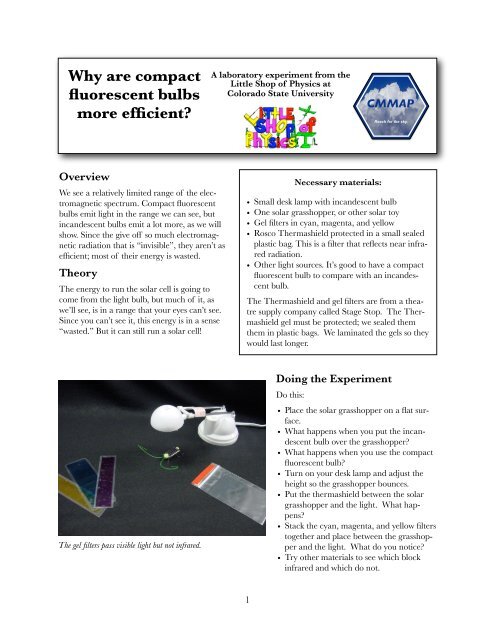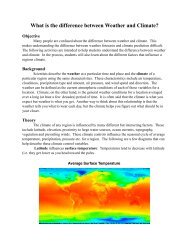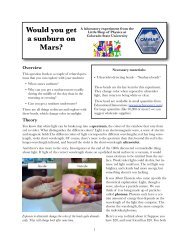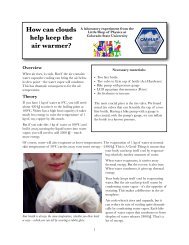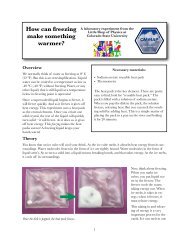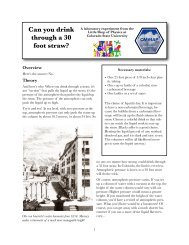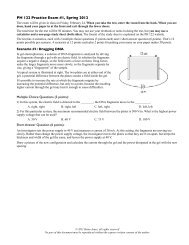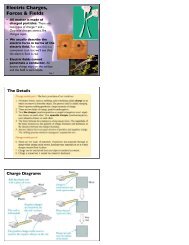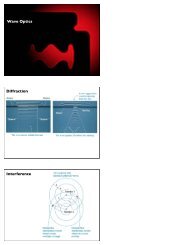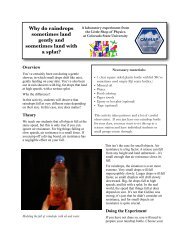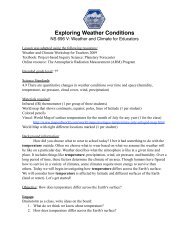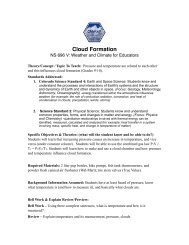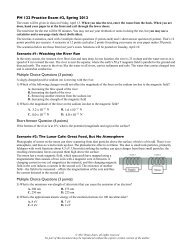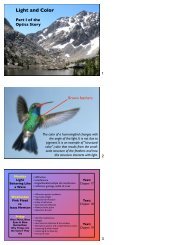Why are compact fluorescent bulbs more efficient? - Little Shop of ...
Why are compact fluorescent bulbs more efficient? - Little Shop of ...
Why are compact fluorescent bulbs more efficient? - Little Shop of ...
Create successful ePaper yourself
Turn your PDF publications into a flip-book with our unique Google optimized e-Paper software.
<strong>Why</strong> <strong>are</strong> <strong>compact</strong><br />
<strong>fluorescent</strong> <strong>bulbs</strong><br />
<strong>more</strong> <strong>efficient</strong>?<br />
Overview<br />
We see a relatively limited range <strong>of</strong> the electromagnetic<br />
spectrum. Compact <strong>fluorescent</strong><br />
<strong>bulbs</strong> emit light in the range we can see, but<br />
incandescent <strong>bulbs</strong> emit a lot <strong>more</strong>, as we will<br />
show. Since the give <strong>of</strong>f so much electromagnetic<br />
radiation that is “invisible”, they <strong>are</strong>n’t as<br />
<strong>efficient</strong>; most <strong>of</strong> their energy is wasted.<br />
Theory<br />
The energy to run the solar cell is going to<br />
come from the light bulb, but much <strong>of</strong> it, as<br />
we’ll see, is in a range that your eyes can’t see.<br />
Since you can’t see it, this energy is in a sense<br />
“wasted.” But it can still run a solar cell!<br />
The gel filters pass visible light but not infr<strong>are</strong>d.<br />
A laboratory experiment from the<br />
<strong>Little</strong> <strong>Shop</strong> <strong>of</strong> Physics at<br />
Colorado State University<br />
1<br />
CMMAP<br />
Reach for the sky.<br />
Doing the Experiment<br />
Do this:<br />
Necessary materials:<br />
• Small desk lamp with incandescent bulb<br />
• One solar grasshopper, or other solar toy<br />
• Gel filters in cyan, magenta, and yellow<br />
• Rosco Thermashield protected in a small sealed<br />
plastic bag. This is a filter that reflects near infr<strong>are</strong>d<br />
radiation.<br />
• Other light sources. It’s good to have a <strong>compact</strong><br />
<strong>fluorescent</strong> bulb to comp<strong>are</strong> with an incandescent<br />
bulb.<br />
The Thermashield and gel filters <strong>are</strong> from a theatre<br />
supply company called Stage Stop. The Thermashield<br />
gel must be protected; we sealed them<br />
them in plastic bags. We laminated the gels so they<br />
would last longer.<br />
• Place the solar grasshopper on a flat surface.<br />
• What happens when you put the incandescent<br />
bulb over the grasshopper?<br />
• What happens when you use the <strong>compact</strong><br />
<strong>fluorescent</strong> bulb?<br />
• Turn on your desk lamp and adjust the<br />
height so the grasshopper bounces.<br />
• Put the thermashield between the solar<br />
grasshopper and the light. What happens?<br />
• Stack the cyan, magenta, and yellow filters<br />
together and place between the grasshopper<br />
and the light. What do you notice?<br />
• Try other materials to see which block<br />
infr<strong>are</strong>d and which do not.
Summing Up<br />
This is a nice way to show the relative efficiency <strong>of</strong> the different <strong>bulbs</strong>.<br />
For More Information<br />
CMMAP, the Center for Multi-Scale Modeling <strong>of</strong> Atmospheric Processes: http://cmmap.colostate.edu<br />
<strong>Little</strong> <strong>Shop</strong> <strong>of</strong> Physics: http://littleshop.physics.colostate.edu<br />
2


